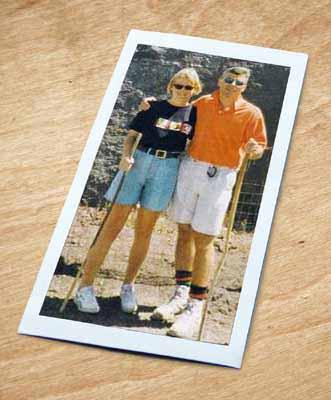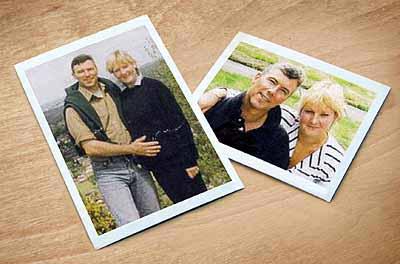
Happier days - a family snapshot of Sally and Steve Clark when they were expecting Christopher
Five years ago, a young couple from Cheshire suffered one of the most devastating losses imaginable - their baby Christopher died in his sleep, aged 11 weeks. Doctors, neighbours, all were sympathetic, and the death was certified as natural causes - there was evidence of a respiratory infection, and no sign of any failure of care.
But just a year later, in what must have felt like a horribly familiar nightmare, the Clarks' second child Harry died, aged 8 weeks. This time, there was no sympathy from the professionals. Four weeks after Harry's death the couple were arrested, and eventually Sally Clark was charged with murdering both children. She was tried and convicted in 1999 and is now almost three years into a life sentence.
The forensic evidence was slim to nonexistent - certainly neither case would have stood up alone. Even the prosecution team disagreed among themselves as to how the two children had died. They claimed first that they had been shaken, then that Sally Clark had smothered them (the forensic indications of these two causes of death are normally quite distinct). There was no evidence that she had been an uncaring or violent mother - in fact, all the evidence pointed in the opposite direction. So how come Sally Clark is serving life in prison? Simply put, because the prosecution argued, and the jury accepted, that lightning does not strike twice.
This homespun piece of "wisdom" was trotted out in court in the guise of a seemingly authoritative statement by paediatrician Sir Roy Meadow, speaking as an expert witness for the prosecution. In probably the most infamous statistical statement ever made in a British courtroom, he claimed that the chance of two children in the same (affluent nonsmoking) family both dying a cot death was 1 in 73 million. This would mean that such a double death would occur less often than once a century in England. Those who attended the trial say that, in the midst of the confusion about whether any crimes had even occurred, and if so, how they had been committed, this statement provided something definite to hold on to. It was widely headlined in the national press. However, there is a problem - this statistic was wrong, irrelevant, biased and totally misleading.
Wrong
This statistic of 1 in 73 million came from the Confidential Enquiry for Stillbirths and Deaths in Infancy (CESDI), an authoritative and detailed study of deaths of babies in five regions of England between 1993 and 1996. There it is estimated that the chances of a randomly chosen baby dying a cot death are 1 in 1,303. If the child is from an affluent, nonsmoking family, with the mother over 26, the odds fall to around 1 in 8,500. The authors go on to say that if there is no link between cot deaths of siblings (because we have eliminated the biggest known and possibly shared factors influencing cot death rates) then we would be able to estimate the chances of two children from such a family both suffering a cot death by squaring 1/8,500 - giving 1 chance in 73 million.
So far so good. But are cot deaths in the same family really independent? The website for the Foundation for the Study of Infant Death (FSID) says baldly that "second cot deaths in the same family are very rare". This is no help, because so are first-sibling cot deaths - what we need to know is, how comparatively rare? Does having one child die a cot death increase the chances that you will have another do so?
Ray Hill, a Professor in the Mathematics Department at Salford University, has carried out a detailed analysis of the data in CESDI, and come to the conclusion that such deaths are most certainly not independent. He estimates that siblings of children who die of cot death are between 10 and 22 times more likely than average to die the same way. Using the figure of 1 in 1,303 for the chance of a first cot death, we see that the chances of a second cot death in the same family are somewhere between 1 in 60 and 1 in 130. There isn't enough data to be more precise, or to take familial factors into account, but it seems reasonable to use a ballpark figure of 1 in 100.
Multiplying 1/1,303 by 1/100 gives an estimate for the incidence of double cot death of around 1 in 130,000. Since 650,000 children are born every year in England and Wales, we can expect around 5 families to suffer a second tragic loss - and this is backed up by the FSID, who say that they hear of one or two such cases every year. Compare this to the figure quoted in Sally Clark's trial, which implied that double cot deaths were so rare that we could expect to them to happen once in a century!
Even without analysing the CESDI report, the assumption of independence should have been regarded as highly suspect. By definition, noone knows what causes cot death - and probably many factors are involved - but it would be very surprising if shared factors such as genetics and household environment played no part at all. The report's authors have publicly stated their disquiet over such a misuse of their work.
Irrelevant

Lightning struck twice - the Clarks when Sally was pregnant with Harry
After all this discussion, you may be surprised to discover that noone - not the prosecution, not the defence, not the coroner - ever claimed that the Clark's first child died a cot death! The original autopsy stated that the child died of natural causes, with evidence of a respiratory infection; the prosecution then claimed that it was murder. Cot death is a "diagnosis of exclusion". A coroner is supposed to write "cot death" or "unexplained" on a death certificate only if a most meticulous process of elimination has taken place, and no other possible cause for the death can be found. This process isn't always carried out, and opinions may differ as to whether minor ailments played a part in the death, which makes it particularly difficult to collect data on cot deaths. But really, cot death statistics should never have been used in court in the first place.
Far more children die of natural causes in general than specifically of cot death. The Campaign to free Sally Clark claim that around fifty families every year in the UK have a second child die naturally. Of course, in many of these cases the cause of death will be very clear, so this figure is not terribly relevant to Sally Clark's case either, but it does lend further weight to the statement that Sally Clark had no real case to answer.
Biased
One of the problems with statistics is that there are so many. Often, such a large number of factors could influence a probability calculation that the choice of which to take into account must be made with the greatest of care in order to avoid charges of bias.
Nobody is suggesting that the prosecution was unscrupulous, but they did have a case to make - after all, that is what a prosecution does. And the statistic that they chose to use took into account all the factors that made cot death less likely in Sally Clark's case and ignored those that made it more likely. For example, both Sally Clark's children were boys. Boys are more likely than girls to die of cot death (nearly two thirds of cot deaths are boys).
Far more importantly, if they wanted to take into account the factors that made cot death less likely in a family like the Clarks, they should also have taken into account the factors making murder less likely in such a family. Home Office figures suggest fewer than 30 mothers a year kill their own child. And in most of these cases the children have been poorly cared for, Social Services have had files on the family, the family is poor, only one parent is on the scene, and so on. No such factor was present in this case. In other words, just as the Clarks were atypical for cot death, they were also atypical for murder - but this fact was completely ignored in the prosecution's single statistic.
Misleading
All these arguments pale into insignificance compared to the final charge that the statistic was totally misleading. There is good reason to believe that the jury completely misunderstood it. Very possibly, as you're reading this, you are making the same mistake. Are you thinking "okay, so the odds aren't as extreme as 1 in 73 million, but they're still astronomically high. There's not that much difference between odds of 1 in 73 million and 1 in 100,000, so Sally Clark must still be guilty." If so, you're committing the "Prosecutor's Fallacy".
Simply put, this is the incorrect belief that the chance of a rare event happening is the same as the chance that the defendant is innocent. Even with the more accurate figure of 1 in 100,000 for the chance that a randomly chosen pair of siblings will both die of cot death, this is not the chance that Sally Clark is innocent. It is the chance that an arbitrary family will lose two children in cot deaths. It's not the most scary statistic you will ever read, but in a big country like England, even such improbable events will happen often enough. Are we to believe, with no evidence, that every mother bereaved in this way is a murderer, just because such an event will only happen a few times a year?
The scales of justice

The scales of justice
So how should you assess the likelihood, in the absence of any reliable forensic evidence, that Sally Clark murdered her two little boys? The tool you need is called Bayes Theorem, and it allows you to combine the probabilities of various events to weigh up their respective relative likelihoods. In nonmathematical language, Bayes Theorem allows you to separate how likely alternative explanations of an event are, from how likely it was that the event should have happened in the first place. (You can read more about Bayes Theorem in Ye banks and Bayes in issue 9 of Plus, and in Random privacy in this issue.)
In Sally Clark's very rare predicament, practically all the improbability is taken up by the fact that two of her children died at all. In the rich world, most children born alive stay alive. So although every possible explanation for their deaths is highly unlikely, this is just because their deaths were unlikely in the first place. But something caused them to die, and to avoid the Prosecutor's Fallacy, the proper thing to do is to decide which explanations are relatively most likely.
In mathematical language, we need to find the conditional probabilities of the various possible causes of death, given the fact that the children died. If H is some hypothesis - for example, that both of Sally Clark’s children died of cot death - and D is some data - that both children are dead, - we want to find the probability of the hypothesis given the data, which is written  . Let’s write
. Let’s write  for the alternate hypothesis - that the children did not die of cot death. We will discount all other possibilities, for example that someone else murdered both children, or that Sally Clark murdered only one of them, or that they died of natural causes other than cot death.
for the alternate hypothesis - that the children did not die of cot death. We will discount all other possibilities, for example that someone else murdered both children, or that Sally Clark murdered only one of them, or that they died of natural causes other than cot death.
 |
(1) |
This is not as complicated as it looks. We already have an estimate for  of 1/100,000. This is an absolute, rather than a conditional, probability - the probability that a random pair of siblings die a cot death, not the probability that a random pair of dead siblings died a cot death. Trivially,
of 1/100,000. This is an absolute, rather than a conditional, probability - the probability that a random pair of siblings die a cot death, not the probability that a random pair of dead siblings died a cot death. Trivially,  is equal to 1. It is the probability that two of the children are dead, given that that two of the children have died of natural causes.
is equal to 1. It is the probability that two of the children are dead, given that that two of the children have died of natural causes.  , being the alternate hypothesis to
, being the alternate hypothesis to  , is equal to
, is equal to 
A completely accurate version of Bayes Theorem would take into account all sorts of factors - for example, the fact that social services had not been involved with the Clark family, their income level, and so on - but there isn’t a sufficient amount of data available to do this. However, if we are only looking to analyse the case against Sally Clark, it is sufficient to make a ball-park estimate, in order to decide whether or not the deaths of two babies provide compelling evidence of guilt. In British trials, there is a presumption of innocence - it is for prosecutions to prove "beyond reasonable doubt" that defendants are guilty, not for defendants to prove their innocence. So all we need to do is to make reasonable estimates and show that these lead to reasonable doubt.
 is the probability that the children died given that they did not die of natural causes. In other words, it is the probability that a randomly chosen pair of siblings will both be murdered. This is the most difficult figure to estimate. Statistics on such double murders are pretty much nonexistent, because child murders are so rare (far, far more rare than cot deaths) and because in most cases, someone known to have murdered once is not free to murder again. So we fall back on the Home Office statistic that fewer than 30 children are known to be murdered by their mother each year in England and Wales. Since 650,000 are born each year, and murders of pairs of siblings are clearly rarer than single murders, we should use a figure much smaller than 30/650,000=0.000046. We will put a number ten times as small here - 0.0000046 - which is almost certainly overestimating the incidence rate of double murder.
is the probability that the children died given that they did not die of natural causes. In other words, it is the probability that a randomly chosen pair of siblings will both be murdered. This is the most difficult figure to estimate. Statistics on such double murders are pretty much nonexistent, because child murders are so rare (far, far more rare than cot deaths) and because in most cases, someone known to have murdered once is not free to murder again. So we fall back on the Home Office statistic that fewer than 30 children are known to be murdered by their mother each year in England and Wales. Since 650,000 are born each year, and murders of pairs of siblings are clearly rarer than single murders, we should use a figure much smaller than 30/650,000=0.000046. We will put a number ten times as small here - 0.0000046 - which is almost certainly overestimating the incidence rate of double murder.
Now we get a rough and ready estimate of Sally Clark’s innocence:
 |
(2) |

Thomas Bayes
I must warn the reader that this figure isn't intended to be in any way an accurate estimate of the likelihood that Sally Clark is innocent. It is only meant to show that, with some reasonable estimates of the likelihoods of relevant events, the scales come down on the side of her innocence rather than her guilt. The only way to disagree with this analysis is to assume that literally hundreds, or thousands, of mothers murder their children undetected every year. The Campaign to Free Sally Clark say that nearly fifty families have contacted them to say that they have suffered double cot deaths. Are we to believe that the majority of these couples are murderers, confident or mad enough to draw attention to themselves in this way?
So to prove that Sally Clark killed her two little boys, the prosecution would need to establish good forensic or other evidence to outweigh the statistics against them. This is in marked contradiction to the prosecution stance, that the statistics practically proved Sally Clark's guilt! In the judge's summing up, he told the jury that "although we do not convict people in these courts on statistics...the statistics in this case do seem compelling". He continued, "this may be part of the evidence to which you attach some significance". Contrary to what was argued in court, that significance points to Sally Clark's innocence.
Is Sally Clark guilty?
From prison, Sally Clark seems remarkably lacking in bitterness. She says that she doesn't blame the jury at all for their decision, and that most probably, if presented with the same "facts", she would have come to the same conclusion. She accepts that only she can know she is innocent. But this is not the point of a trial. It is not for her to prove her innocence, but for the prosecution to prove her guilt.
So I'm not going to answer the question "Is Sally Clark guilty?". To me, it seems that it should never have been asked in the first place.
Plus readers may be interested to know that Sally Clark's case has been referred to the Appeal Court for a second time. Evidence, not made available to her original defence team, has recently come to light that at the time of Harry's death, he was suffering from a bacterial blood infection known to cause sudden infant death.
If this appeal is successful, Sally Clark will be reunited with her husband and their third son, born while she was on bail and brought up without his mother for almost his entire life.
About this article
Helen Joyce is Editor of Plus.

David MacKay
For this article, Helen interviewed David Mackay, a researcher on Information Systems at the Cavendish Laboratory at Cambridge, who is closely involved in the Campaign to free Sally Clark.
If you would like to know more about the case and the campaign, visit the campaign website. You might like to write to your MP or to Sally Clark herself - details are provided at the site.

Ray Hill
Ray Hill, Professor of Mathematics at Salford University, kindly sent her his two papers, "Why Sally Clark is, probably, innocent" and "Cot Death or Murder? - Weighing the Probabilities".
If you would like to receive copies or to ask Professor Hill more about the use of statistics in this case, you can email him at R.Hill@salford.ac.uk.
This article now forms part of our coverage of the cutting-edge research done at the Isaac Newton Institute for Mathematical Sciences (INI) in Cambridge. The INI is an international research centre and our neighbour here on the University of Cambridge's maths campus. It attracts leading mathematical scientists from all over the world, and is open to all. Visit www.newton.ac.uk to find out more.

Comments
sally
if there is no evidence proving that she hurt the baby in any way she should not be convicted
The misinterpretation of numbers...
Excellent analysis. Just shows the harm of half-knowledge. Wish the "learned" judge had the prof by his side when he was listening to arguments.
Beyond reasonable doubt
You cite,as the probability,the incidence rate in a small sample.
Could we have the 95% confidence interval?
This calculation seems to be wrong
This calculation seems to be wrong because in your terms P(D|A) is the probability that if a child was murdered by parents it has signs of SID. But you interpreted it as P(A) - probability that a child was killed by parents
Update
The appeal was successful, and she was reunited with her son. However, she then died due to alcohol intoxication on 3/16/2007, though the coroner stressed that there is no evidence that she committed suicide.